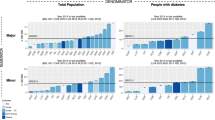Abstract
The purpose of this report was to compare lower extremity amputation rates between areas of the United States and areas outside the United States using a standard format. Twelve U.S. counties similar in size, income, and land use were selected. The rate of amputation for each county was developed following the method and definitions described by the Global Lower Extremity Amputation Study (GLEAS). The data were compared to rates of amputation for non-U.S. areas that participated in the GLEAS. The U.S. counties generally had higher amputation rates than the non-U.S. areas in this standardized comparison. The United States suffers a high number of lower extremity amputations in comparison to other developed countries. The effectiveness of prevention strategies in the United States needs to be reevaluated and new strategies explored.
Similar content being viewed by others
References
Wrobel J, Mayfield J, Reiber G. Geographic variation of lower extremity major amputation in individuals with and without diabetes in the Medicare population. Diabetes Care 2001;24:860–865
Global Lower Extremity Amputation Study Group. Epidemiology of lower extremity amputations in centers in Europe, North America and East Asia. Br J Surg 2000;87:328–337
Feinglass J, Brown JL, LoSassso A, et al. Rates of lower extremity amputation and arterial reconstruction in the United States, 1979 to 1996. Am J Public Health 1999;89:1222–1226.
Berthelson C. Evaluation of coding data quality of the HCUP National Inpatient Sample. Top Health Inform Manage 2000;21:10–23
Gaquin D ed. 2000 County and City Extra Metro City and County Data Book, 9th ed. Lanham, MD: Bernan, 2000
Amos AF, McCarty DJ, Zimmer P. The rising global burden of diabetes and its complications: estimates and projections to the year 2010. Diabetes Med 1997;14(Suppl. 5):S1–S85
Mayfield JA, Reiber GE, Maynard C, et al. Trends in lower limb amputation in the Veterans Health Administration, 1989–1998. J Rehab Res Dev 2000;37:23–30
Calle-Pascual AL, et al. Epidemiology of nontraumatic lower-extremity amputations in area 7, Madrid, between 1989 and 1999. Diabetes Care 2001;24:1686–1689
Leggetter S, Chatturvedi N, Fuller JH, Edmonds ME. Ethnicity and risk of diabetes-related lower extremity amputation. Arch Intern Med 2002;162:73–79
Chaturvedi N, Abbott CA, Whalley A, Widdows P, Leggetter SY, Boulton AJM. Risk of diabetes-related amputation in south Asians vs. Europeans in the UK. Diabetes Med 2002;19:99–104.
Acknowledgement
The authors thank Daphne Ewing, Betty O’Hanian, and Tim Kelly for their help with data management.
Author information
Authors and Affiliations
Corresponding author
About this article
Cite this article
Renzi, R., Unwin, N., Jubelirer, R. et al. An International Comparison of Lower Extremity Amputation Rates. Ann Vasc Surg 20, 346–350 (2006). https://doi.org/10.1007/s10016-006-9044-9
Received:
Revised:
Accepted:
Published:
Issue Date:
DOI: https://doi.org/10.1007/s10016-006-9044-9




